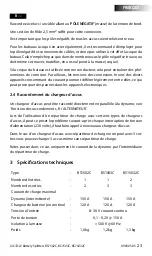
090305.05
11
vetus®
Battery Splitters BS1502C, BS1503C, BS15032C
+ BATTERY
Connect the cable to the plus (+) terminal of the respective battery.
B —
Connect a cable from this terminal to the
minus
terminal (ground) of the ship’s
power supply system.
A wire cross-section of 2.5 mm
2
(AWG 14) is sufficient for this interconnection.
It is important that the minus terminals of all batteries are interconnected.
Also for a ship with a steel hull it is recommended to use cables for all minus con-
nections instead of using the ship’s hull. That does not alter the fact that in most
cases the minus terminal is or even must be grounded at one (1) point (connected
to the hull).
In cases where the ship’s hull is used as a conductor this may result in corrosion. In
addition there may occur some difference in the voltage at the minus terminals of
the various consumers, which may result in malfunction of electronic equipment.
2.4 Connection of battery charger
A battery charger can be connected directly in parallel to the alternator; see ‘Func-
tion of the terminals, B+ ALTERNATOR’.
If the battery splitter is used in combination with certain types of battery chargers
the problem may arise that every time the power supply (230 Volt) has been inter-
rupted the charger must be switched on again.
A battery charger with built-in battery splitter gives the possibility to charge 3 bat-
teries without the use of an extra battery splitter.
In such a case use the battery splitter only for the charge current of the alternator.
3 Technical data
Model
:
BS1502C
BS1503C
BS15032C
Number of inputs
:
1
1
2
Number of outputs
:
2
3
3
Maximum charging current
Alternator (intermittent)
:
150 A
150 A
150 A
Battery charger (continuous) :
120 A
120 A
120 A
Input voltage
:
8 - 30 V DC
Forward voltage drop
:
0.1 - 0.2 V at 150 A
Insulation to ground
:
> 500 V @ 60 Hz
Weight
: 1.0 kg (2.2 lbs) 1.2 kg (2.6 lbs) 1.3 kg (2.9 lbs)
ENGLISH












































